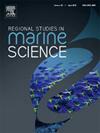韩国沿海沉积物有机质污染控制因素及污染评价
IF 2.1
4区 环境科学与生态学
Q3 ECOLOGY
引用次数: 0
摘要
利用韩国国家海洋生态系统监测计划(2017-2022)的数据,研究了海洋环境管理法指定的五个生态区的有机质时空分布。采用三种分析方法确定影响有机质分布的关键因素:(1)与沉积物颗粒表面积和粘土含量的相关性;(2)有机质来源表征;(3)沉积生产力评价。建立了各生态区的背景浓度,反映了各生态区独特的沉积特征。根据这些基线,污染趋势在西海中部和南海西部呈下降趋势,而在东海、大韩海峡和济州海呈上升趋势。尽管在定义背景浓度和污染阈值方面存在一定的方法局限性,但本研究为有机物污染的驱动因素提供了有价值的见解,并为未来的环境评估和沿海管理策略提供了必要的基线数据。本文章由计算机程序翻译,如有差异,请以英文原文为准。
Control factors and contamination assessment of organic matter in Korean coastal sediments
Using data from the Korea National Marine Ecosystem Monitoring Program (2017–2022), this study investigates the spatiotemporal distribution of organic matter across five ecoregions designated by the Marine Environment Management Act. Three analytical approaches were applied to identify key factors influencing organic matter distribution: (1) correlation with sediment particle surface area and clay content, (2) characterization of organic matter sources, and (3) evaluation of sedimentary productivity. Background concentrations were established for each ecoregion, reflecting their unique sedimentary characteristics. Based on these baselines, contamination trends were found to be decreasing in the Central West Sea and Western South Sea, while increasing in the East Sea, Korea Strait, and Jeju Sea. Despite certain methodological limitations in defining background concentrations and contamination thresholds, this study provides valuable insights into the drivers of organic matter contamination and offers essential baseline data for future environmental assessments and coastal management strategies.
求助全文
通过发布文献求助,成功后即可免费获取论文全文。
去求助
来源期刊

Regional Studies in Marine Science
Agricultural and Biological Sciences-Ecology, Evolution, Behavior and Systematics
CiteScore
3.90
自引率
4.80%
发文量
336
审稿时长
69 days
期刊介绍:
REGIONAL STUDIES IN MARINE SCIENCE will publish scientifically sound papers on regional aspects of maritime and marine resources in estuaries, coastal zones, continental shelf, the seas and oceans.
 求助内容:
求助内容: 应助结果提醒方式:
应助结果提醒方式:


